Comprehensive Evaluation of Leadership Theories Article (Course Name)
VerifiedAdded on 2022/12/22
|7
|1901
|75
Report
AI Summary
This report offers a critical evaluation of an article by Derue, Nahrgang, Wellman, and Humphrey (2011), focusing on the integration of trait and behavioral theories of leadership. The evaluation examines the article's introduction, which highlights the need for theoretical integration in leadership literature, and then proceeds to analyze the theories discussed, including leader traits (gender, intelligence, personality) and behaviors (transformational-transactional, initiating structure-consideration). The report assesses the methods used, such as meta-analytic research, and discusses the limitations of the approach. It also reviews the findings, which suggest an integrative model where leader behaviors mediate the relationship between leader traits and effectiveness. The evaluation considers the article's strengths, weaknesses, and consistency in relation to the topic of leadership effectiveness, concluding with an overview of the study's contributions and potential areas for future research. The report also touches upon the limitations of the study and suggests areas for improvement.
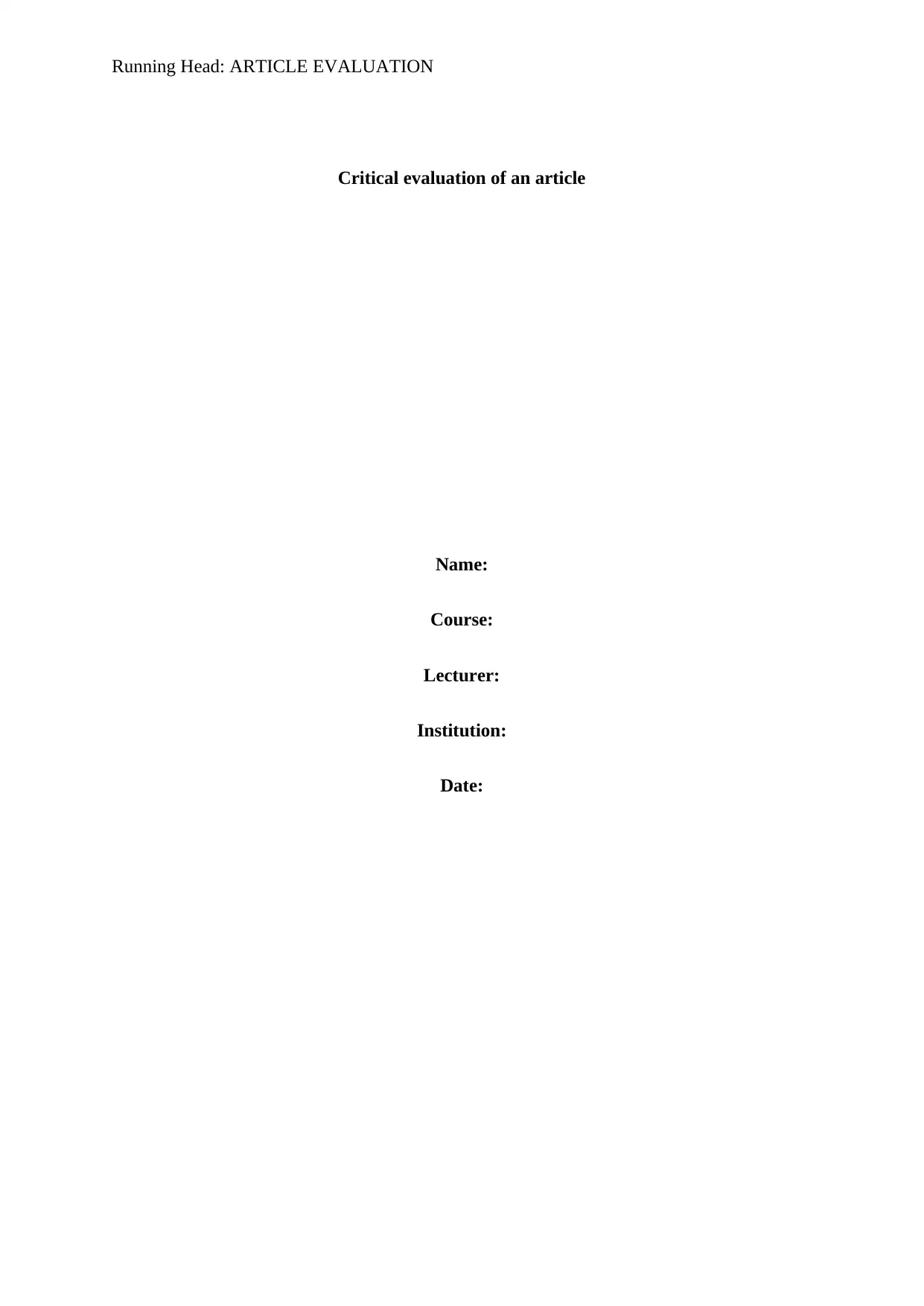
Running Head: ARTICLE EVALUATION
Critical evaluation of an article
Name:
Course:
Lecturer:
Institution:
Date:
Critical evaluation of an article
Name:
Course:
Lecturer:
Institution:
Date:
Paraphrase This Document
Need a fresh take? Get an instant paraphrase of this document with our AI Paraphraser
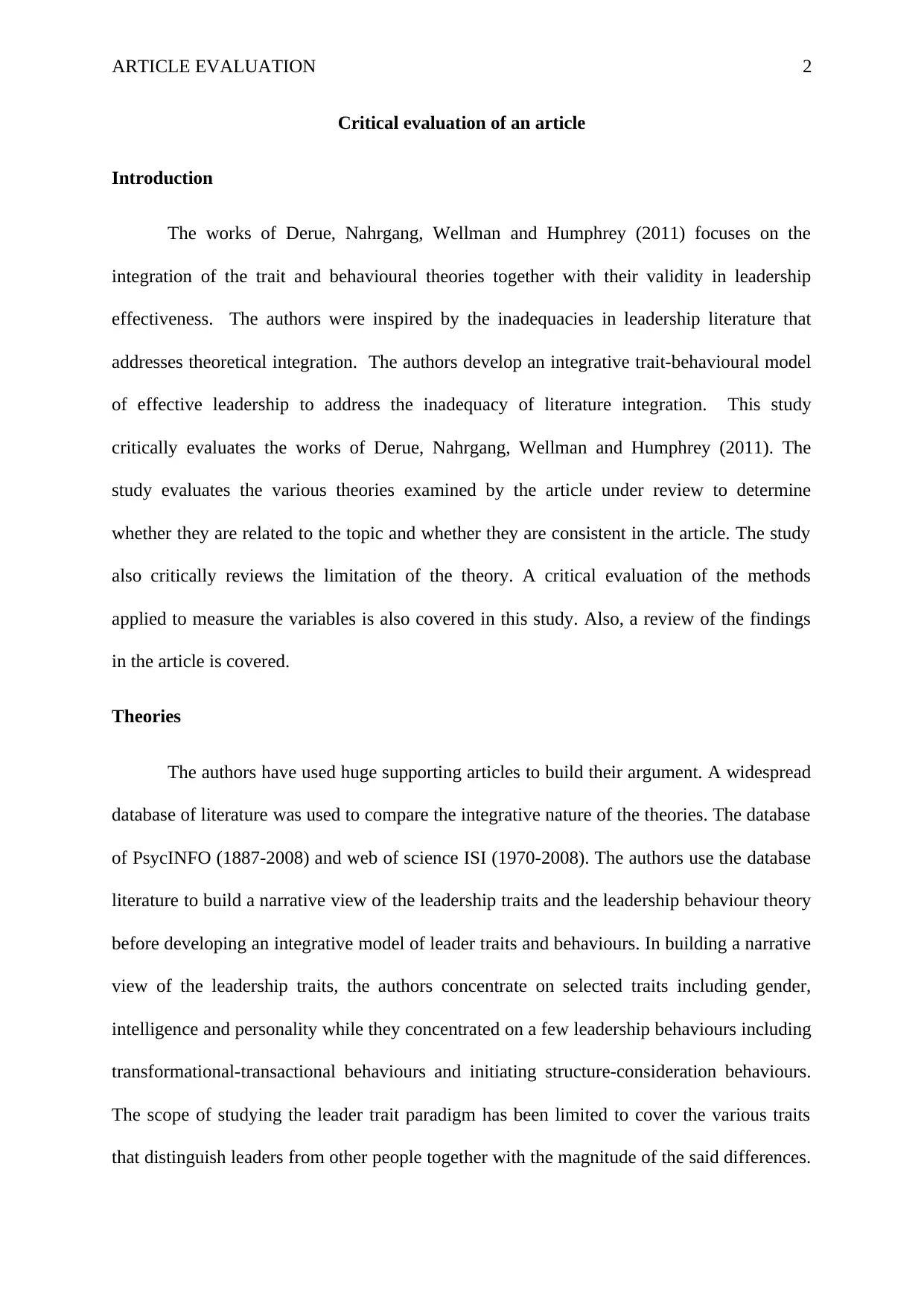
ARTICLE EVALUATION 2
Critical evaluation of an article
Introduction
The works of Derue, Nahrgang, Wellman and Humphrey (2011) focuses on the
integration of the trait and behavioural theories together with their validity in leadership
effectiveness. The authors were inspired by the inadequacies in leadership literature that
addresses theoretical integration. The authors develop an integrative trait-behavioural model
of effective leadership to address the inadequacy of literature integration. This study
critically evaluates the works of Derue, Nahrgang, Wellman and Humphrey (2011). The
study evaluates the various theories examined by the article under review to determine
whether they are related to the topic and whether they are consistent in the article. The study
also critically reviews the limitation of the theory. A critical evaluation of the methods
applied to measure the variables is also covered in this study. Also, a review of the findings
in the article is covered.
Theories
The authors have used huge supporting articles to build their argument. A widespread
database of literature was used to compare the integrative nature of the theories. The database
of PsycINFO (1887-2008) and web of science ISI (1970-2008). The authors use the database
literature to build a narrative view of the leadership traits and the leadership behaviour theory
before developing an integrative model of leader traits and behaviours. In building a narrative
view of the leadership traits, the authors concentrate on selected traits including gender,
intelligence and personality while they concentrated on a few leadership behaviours including
transformational-transactional behaviours and initiating structure-consideration behaviours.
The scope of studying the leader trait paradigm has been limited to cover the various traits
that distinguish leaders from other people together with the magnitude of the said differences.
Critical evaluation of an article
Introduction
The works of Derue, Nahrgang, Wellman and Humphrey (2011) focuses on the
integration of the trait and behavioural theories together with their validity in leadership
effectiveness. The authors were inspired by the inadequacies in leadership literature that
addresses theoretical integration. The authors develop an integrative trait-behavioural model
of effective leadership to address the inadequacy of literature integration. This study
critically evaluates the works of Derue, Nahrgang, Wellman and Humphrey (2011). The
study evaluates the various theories examined by the article under review to determine
whether they are related to the topic and whether they are consistent in the article. The study
also critically reviews the limitation of the theory. A critical evaluation of the methods
applied to measure the variables is also covered in this study. Also, a review of the findings
in the article is covered.
Theories
The authors have used huge supporting articles to build their argument. A widespread
database of literature was used to compare the integrative nature of the theories. The database
of PsycINFO (1887-2008) and web of science ISI (1970-2008). The authors use the database
literature to build a narrative view of the leadership traits and the leadership behaviour theory
before developing an integrative model of leader traits and behaviours. In building a narrative
view of the leadership traits, the authors concentrate on selected traits including gender,
intelligence and personality while they concentrated on a few leadership behaviours including
transformational-transactional behaviours and initiating structure-consideration behaviours.
The scope of studying the leader trait paradigm has been limited to cover the various traits
that distinguish leaders from other people together with the magnitude of the said differences.
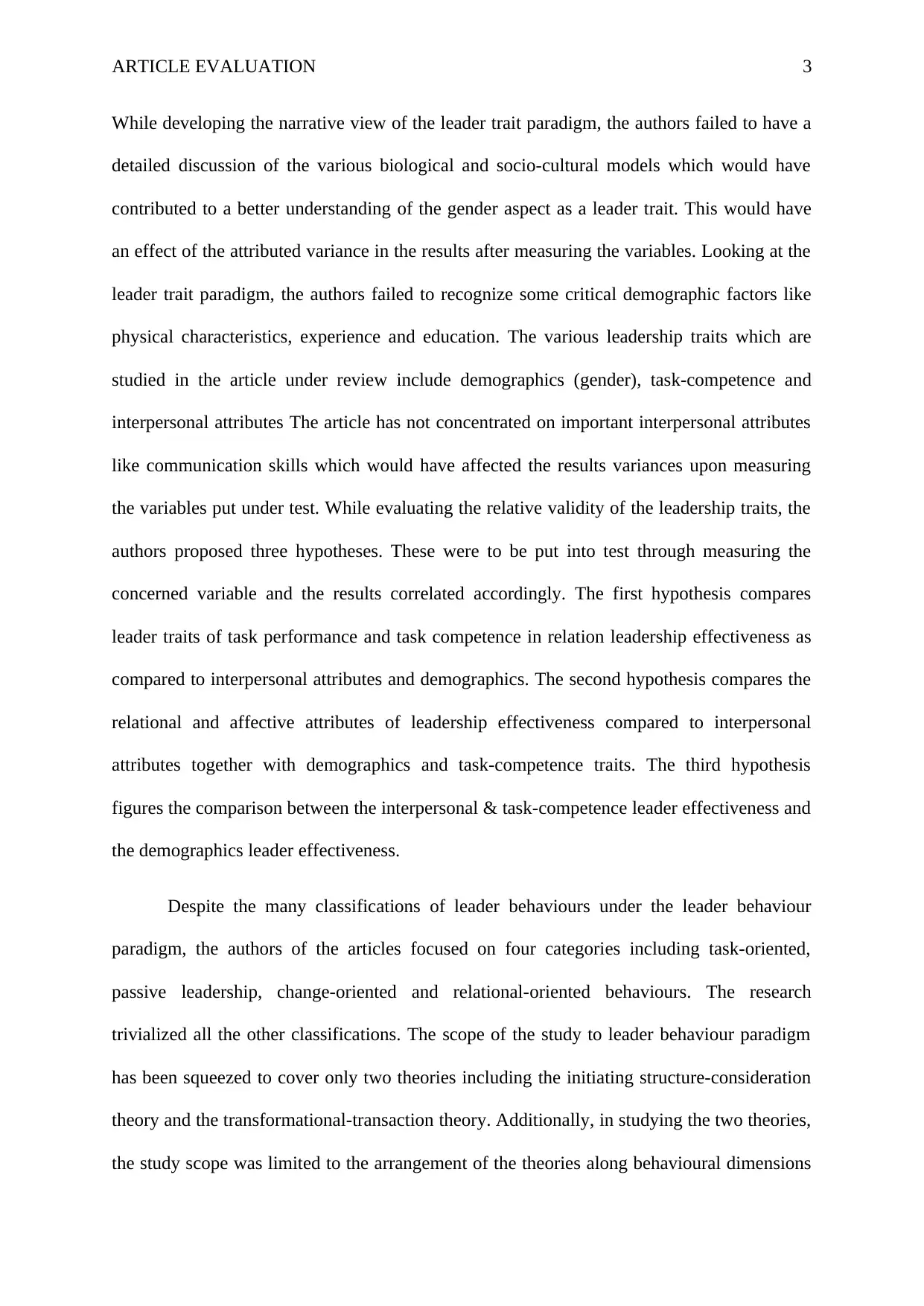
ARTICLE EVALUATION 3
While developing the narrative view of the leader trait paradigm, the authors failed to have a
detailed discussion of the various biological and socio-cultural models which would have
contributed to a better understanding of the gender aspect as a leader trait. This would have
an effect of the attributed variance in the results after measuring the variables. Looking at the
leader trait paradigm, the authors failed to recognize some critical demographic factors like
physical characteristics, experience and education. The various leadership traits which are
studied in the article under review include demographics (gender), task-competence and
interpersonal attributes The article has not concentrated on important interpersonal attributes
like communication skills which would have affected the results variances upon measuring
the variables put under test. While evaluating the relative validity of the leadership traits, the
authors proposed three hypotheses. These were to be put into test through measuring the
concerned variable and the results correlated accordingly. The first hypothesis compares
leader traits of task performance and task competence in relation leadership effectiveness as
compared to interpersonal attributes and demographics. The second hypothesis compares the
relational and affective attributes of leadership effectiveness compared to interpersonal
attributes together with demographics and task-competence traits. The third hypothesis
figures the comparison between the interpersonal & task-competence leader effectiveness and
the demographics leader effectiveness.
Despite the many classifications of leader behaviours under the leader behaviour
paradigm, the authors of the articles focused on four categories including task-oriented,
passive leadership, change-oriented and relational-oriented behaviours. The research
trivialized all the other classifications. The scope of the study to leader behaviour paradigm
has been squeezed to cover only two theories including the initiating structure-consideration
theory and the transformational-transaction theory. Additionally, in studying the two theories,
the study scope was limited to the arrangement of the theories along behavioural dimensions
While developing the narrative view of the leader trait paradigm, the authors failed to have a
detailed discussion of the various biological and socio-cultural models which would have
contributed to a better understanding of the gender aspect as a leader trait. This would have
an effect of the attributed variance in the results after measuring the variables. Looking at the
leader trait paradigm, the authors failed to recognize some critical demographic factors like
physical characteristics, experience and education. The various leadership traits which are
studied in the article under review include demographics (gender), task-competence and
interpersonal attributes The article has not concentrated on important interpersonal attributes
like communication skills which would have affected the results variances upon measuring
the variables put under test. While evaluating the relative validity of the leadership traits, the
authors proposed three hypotheses. These were to be put into test through measuring the
concerned variable and the results correlated accordingly. The first hypothesis compares
leader traits of task performance and task competence in relation leadership effectiveness as
compared to interpersonal attributes and demographics. The second hypothesis compares the
relational and affective attributes of leadership effectiveness compared to interpersonal
attributes together with demographics and task-competence traits. The third hypothesis
figures the comparison between the interpersonal & task-competence leader effectiveness and
the demographics leader effectiveness.
Despite the many classifications of leader behaviours under the leader behaviour
paradigm, the authors of the articles focused on four categories including task-oriented,
passive leadership, change-oriented and relational-oriented behaviours. The research
trivialized all the other classifications. The scope of the study to leader behaviour paradigm
has been squeezed to cover only two theories including the initiating structure-consideration
theory and the transformational-transaction theory. Additionally, in studying the two theories,
the study scope was limited to the arrangement of the theories along behavioural dimensions
⊘ This is a preview!⊘
Do you want full access?
Subscribe today to unlock all pages.

Trusted by 1+ million students worldwide
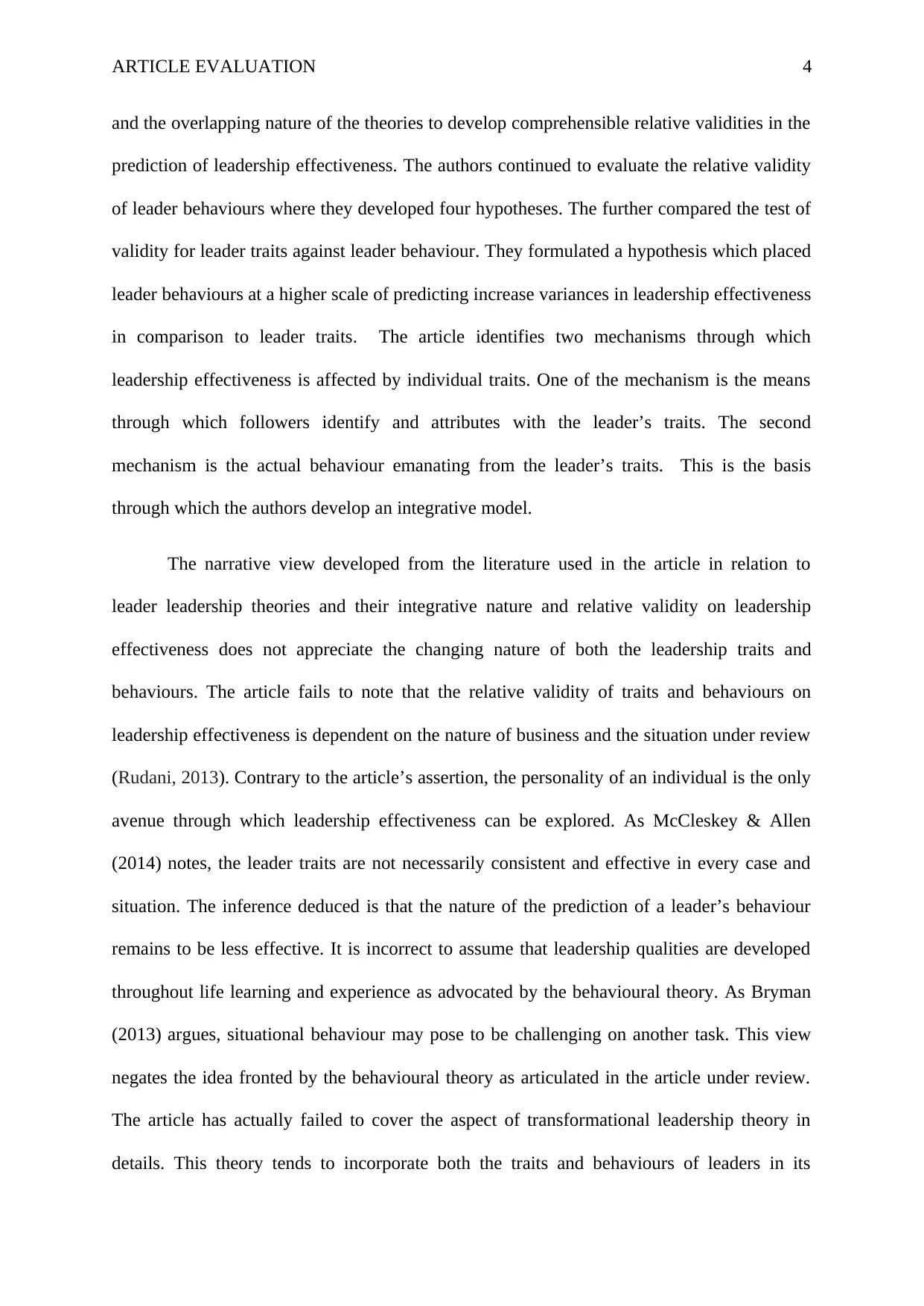
ARTICLE EVALUATION 4
and the overlapping nature of the theories to develop comprehensible relative validities in the
prediction of leadership effectiveness. The authors continued to evaluate the relative validity
of leader behaviours where they developed four hypotheses. The further compared the test of
validity for leader traits against leader behaviour. They formulated a hypothesis which placed
leader behaviours at a higher scale of predicting increase variances in leadership effectiveness
in comparison to leader traits. The article identifies two mechanisms through which
leadership effectiveness is affected by individual traits. One of the mechanism is the means
through which followers identify and attributes with the leader’s traits. The second
mechanism is the actual behaviour emanating from the leader’s traits. This is the basis
through which the authors develop an integrative model.
The narrative view developed from the literature used in the article in relation to
leader leadership theories and their integrative nature and relative validity on leadership
effectiveness does not appreciate the changing nature of both the leadership traits and
behaviours. The article fails to note that the relative validity of traits and behaviours on
leadership effectiveness is dependent on the nature of business and the situation under review
(Rudani, 2013). Contrary to the article’s assertion, the personality of an individual is the only
avenue through which leadership effectiveness can be explored. As McCleskey & Allen
(2014) notes, the leader traits are not necessarily consistent and effective in every case and
situation. The inference deduced is that the nature of the prediction of a leader’s behaviour
remains to be less effective. It is incorrect to assume that leadership qualities are developed
throughout life learning and experience as advocated by the behavioural theory. As Bryman
(2013) argues, situational behaviour may pose to be challenging on another task. This view
negates the idea fronted by the behavioural theory as articulated in the article under review.
The article has actually failed to cover the aspect of transformational leadership theory in
details. This theory tends to incorporate both the traits and behaviours of leaders in its
and the overlapping nature of the theories to develop comprehensible relative validities in the
prediction of leadership effectiveness. The authors continued to evaluate the relative validity
of leader behaviours where they developed four hypotheses. The further compared the test of
validity for leader traits against leader behaviour. They formulated a hypothesis which placed
leader behaviours at a higher scale of predicting increase variances in leadership effectiveness
in comparison to leader traits. The article identifies two mechanisms through which
leadership effectiveness is affected by individual traits. One of the mechanism is the means
through which followers identify and attributes with the leader’s traits. The second
mechanism is the actual behaviour emanating from the leader’s traits. This is the basis
through which the authors develop an integrative model.
The narrative view developed from the literature used in the article in relation to
leader leadership theories and their integrative nature and relative validity on leadership
effectiveness does not appreciate the changing nature of both the leadership traits and
behaviours. The article fails to note that the relative validity of traits and behaviours on
leadership effectiveness is dependent on the nature of business and the situation under review
(Rudani, 2013). Contrary to the article’s assertion, the personality of an individual is the only
avenue through which leadership effectiveness can be explored. As McCleskey & Allen
(2014) notes, the leader traits are not necessarily consistent and effective in every case and
situation. The inference deduced is that the nature of the prediction of a leader’s behaviour
remains to be less effective. It is incorrect to assume that leadership qualities are developed
throughout life learning and experience as advocated by the behavioural theory. As Bryman
(2013) argues, situational behaviour may pose to be challenging on another task. This view
negates the idea fronted by the behavioural theory as articulated in the article under review.
The article has actually failed to cover the aspect of transformational leadership theory in
details. This theory tends to incorporate both the traits and behaviours of leaders in its
Paraphrase This Document
Need a fresh take? Get an instant paraphrase of this document with our AI Paraphraser
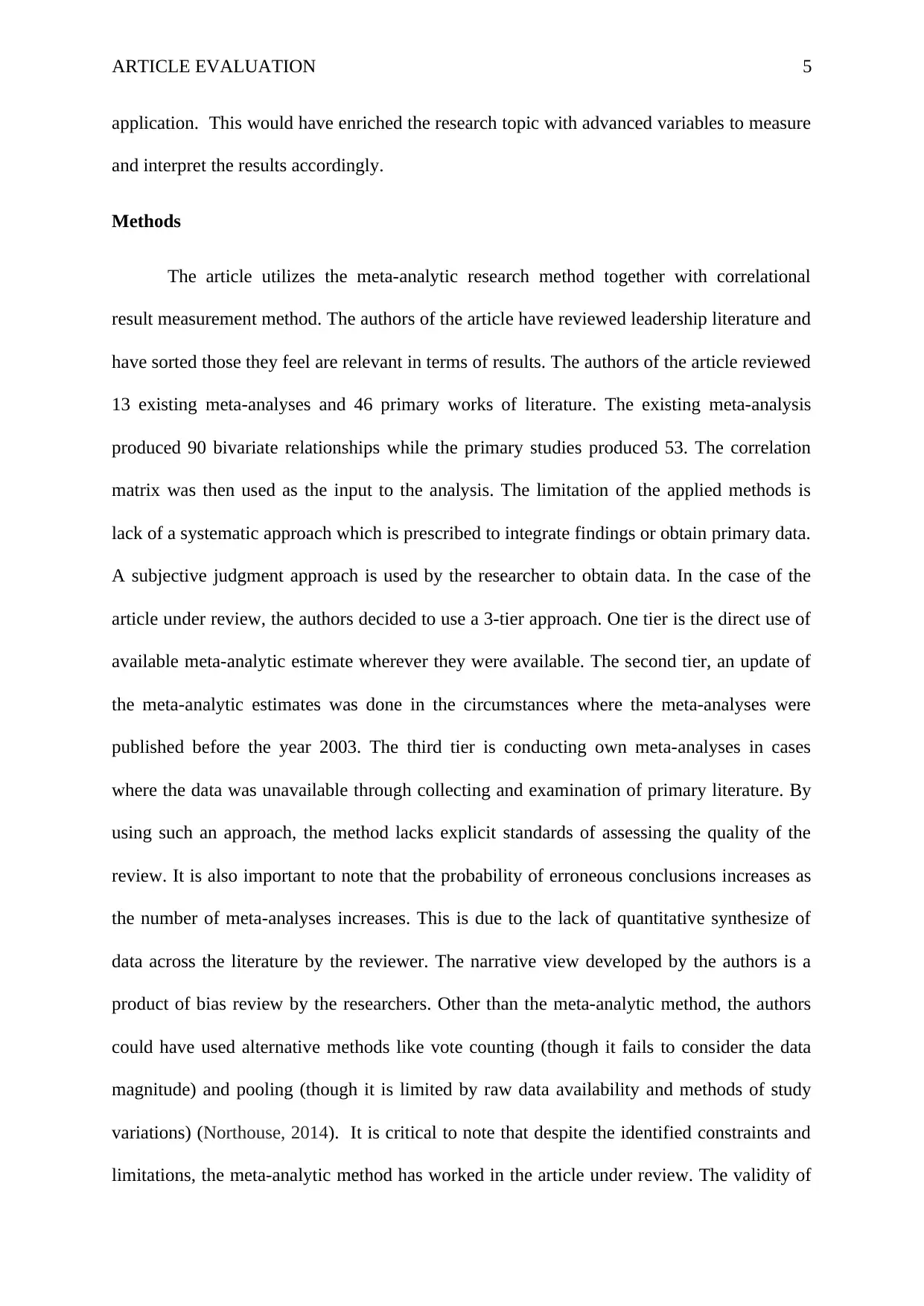
ARTICLE EVALUATION 5
application. This would have enriched the research topic with advanced variables to measure
and interpret the results accordingly.
Methods
The article utilizes the meta-analytic research method together with correlational
result measurement method. The authors of the article have reviewed leadership literature and
have sorted those they feel are relevant in terms of results. The authors of the article reviewed
13 existing meta-analyses and 46 primary works of literature. The existing meta-analysis
produced 90 bivariate relationships while the primary studies produced 53. The correlation
matrix was then used as the input to the analysis. The limitation of the applied methods is
lack of a systematic approach which is prescribed to integrate findings or obtain primary data.
A subjective judgment approach is used by the researcher to obtain data. In the case of the
article under review, the authors decided to use a 3-tier approach. One tier is the direct use of
available meta-analytic estimate wherever they were available. The second tier, an update of
the meta-analytic estimates was done in the circumstances where the meta-analyses were
published before the year 2003. The third tier is conducting own meta-analyses in cases
where the data was unavailable through collecting and examination of primary literature. By
using such an approach, the method lacks explicit standards of assessing the quality of the
review. It is also important to note that the probability of erroneous conclusions increases as
the number of meta-analyses increases. This is due to the lack of quantitative synthesize of
data across the literature by the reviewer. The narrative view developed by the authors is a
product of bias review by the researchers. Other than the meta-analytic method, the authors
could have used alternative methods like vote counting (though it fails to consider the data
magnitude) and pooling (though it is limited by raw data availability and methods of study
variations) (Northouse, 2014). It is critical to note that despite the identified constraints and
limitations, the meta-analytic method has worked in the article under review. The validity of
application. This would have enriched the research topic with advanced variables to measure
and interpret the results accordingly.
Methods
The article utilizes the meta-analytic research method together with correlational
result measurement method. The authors of the article have reviewed leadership literature and
have sorted those they feel are relevant in terms of results. The authors of the article reviewed
13 existing meta-analyses and 46 primary works of literature. The existing meta-analysis
produced 90 bivariate relationships while the primary studies produced 53. The correlation
matrix was then used as the input to the analysis. The limitation of the applied methods is
lack of a systematic approach which is prescribed to integrate findings or obtain primary data.
A subjective judgment approach is used by the researcher to obtain data. In the case of the
article under review, the authors decided to use a 3-tier approach. One tier is the direct use of
available meta-analytic estimate wherever they were available. The second tier, an update of
the meta-analytic estimates was done in the circumstances where the meta-analyses were
published before the year 2003. The third tier is conducting own meta-analyses in cases
where the data was unavailable through collecting and examination of primary literature. By
using such an approach, the method lacks explicit standards of assessing the quality of the
review. It is also important to note that the probability of erroneous conclusions increases as
the number of meta-analyses increases. This is due to the lack of quantitative synthesize of
data across the literature by the reviewer. The narrative view developed by the authors is a
product of bias review by the researchers. Other than the meta-analytic method, the authors
could have used alternative methods like vote counting (though it fails to consider the data
magnitude) and pooling (though it is limited by raw data availability and methods of study
variations) (Northouse, 2014). It is critical to note that despite the identified constraints and
limitations, the meta-analytic method has worked in the article under review. The validity of
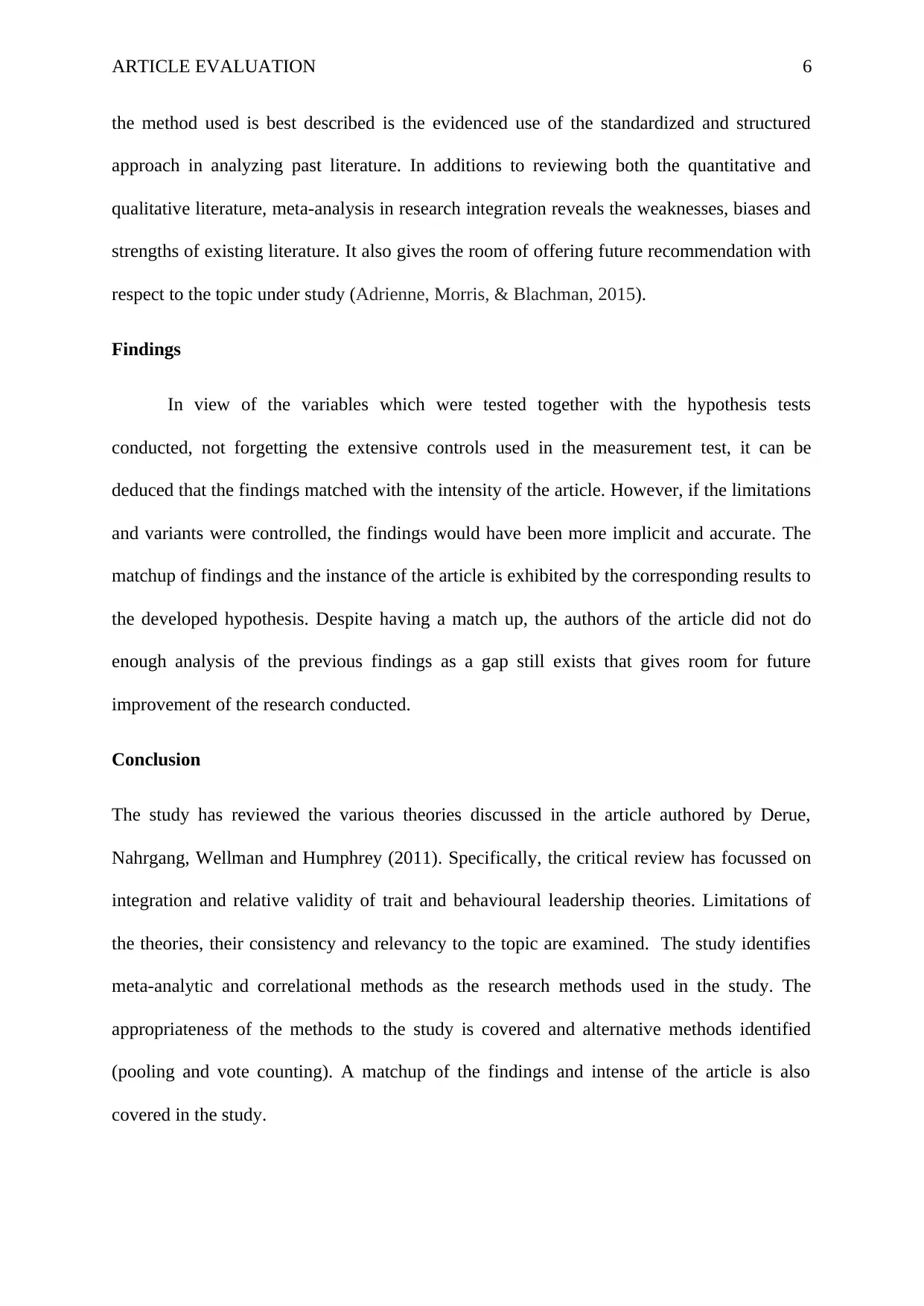
ARTICLE EVALUATION 6
the method used is best described is the evidenced use of the standardized and structured
approach in analyzing past literature. In additions to reviewing both the quantitative and
qualitative literature, meta-analysis in research integration reveals the weaknesses, biases and
strengths of existing literature. It also gives the room of offering future recommendation with
respect to the topic under study (Adrienne, Morris, & Blachman, 2015).
Findings
In view of the variables which were tested together with the hypothesis tests
conducted, not forgetting the extensive controls used in the measurement test, it can be
deduced that the findings matched with the intensity of the article. However, if the limitations
and variants were controlled, the findings would have been more implicit and accurate. The
matchup of findings and the instance of the article is exhibited by the corresponding results to
the developed hypothesis. Despite having a match up, the authors of the article did not do
enough analysis of the previous findings as a gap still exists that gives room for future
improvement of the research conducted.
Conclusion
The study has reviewed the various theories discussed in the article authored by Derue,
Nahrgang, Wellman and Humphrey (2011). Specifically, the critical review has focussed on
integration and relative validity of trait and behavioural leadership theories. Limitations of
the theories, their consistency and relevancy to the topic are examined. The study identifies
meta-analytic and correlational methods as the research methods used in the study. The
appropriateness of the methods to the study is covered and alternative methods identified
(pooling and vote counting). A matchup of the findings and intense of the article is also
covered in the study.
the method used is best described is the evidenced use of the standardized and structured
approach in analyzing past literature. In additions to reviewing both the quantitative and
qualitative literature, meta-analysis in research integration reveals the weaknesses, biases and
strengths of existing literature. It also gives the room of offering future recommendation with
respect to the topic under study (Adrienne, Morris, & Blachman, 2015).
Findings
In view of the variables which were tested together with the hypothesis tests
conducted, not forgetting the extensive controls used in the measurement test, it can be
deduced that the findings matched with the intensity of the article. However, if the limitations
and variants were controlled, the findings would have been more implicit and accurate. The
matchup of findings and the instance of the article is exhibited by the corresponding results to
the developed hypothesis. Despite having a match up, the authors of the article did not do
enough analysis of the previous findings as a gap still exists that gives room for future
improvement of the research conducted.
Conclusion
The study has reviewed the various theories discussed in the article authored by Derue,
Nahrgang, Wellman and Humphrey (2011). Specifically, the critical review has focussed on
integration and relative validity of trait and behavioural leadership theories. Limitations of
the theories, their consistency and relevancy to the topic are examined. The study identifies
meta-analytic and correlational methods as the research methods used in the study. The
appropriateness of the methods to the study is covered and alternative methods identified
(pooling and vote counting). A matchup of the findings and intense of the article is also
covered in the study.
⊘ This is a preview!⊘
Do you want full access?
Subscribe today to unlock all pages.

Trusted by 1+ million students worldwide
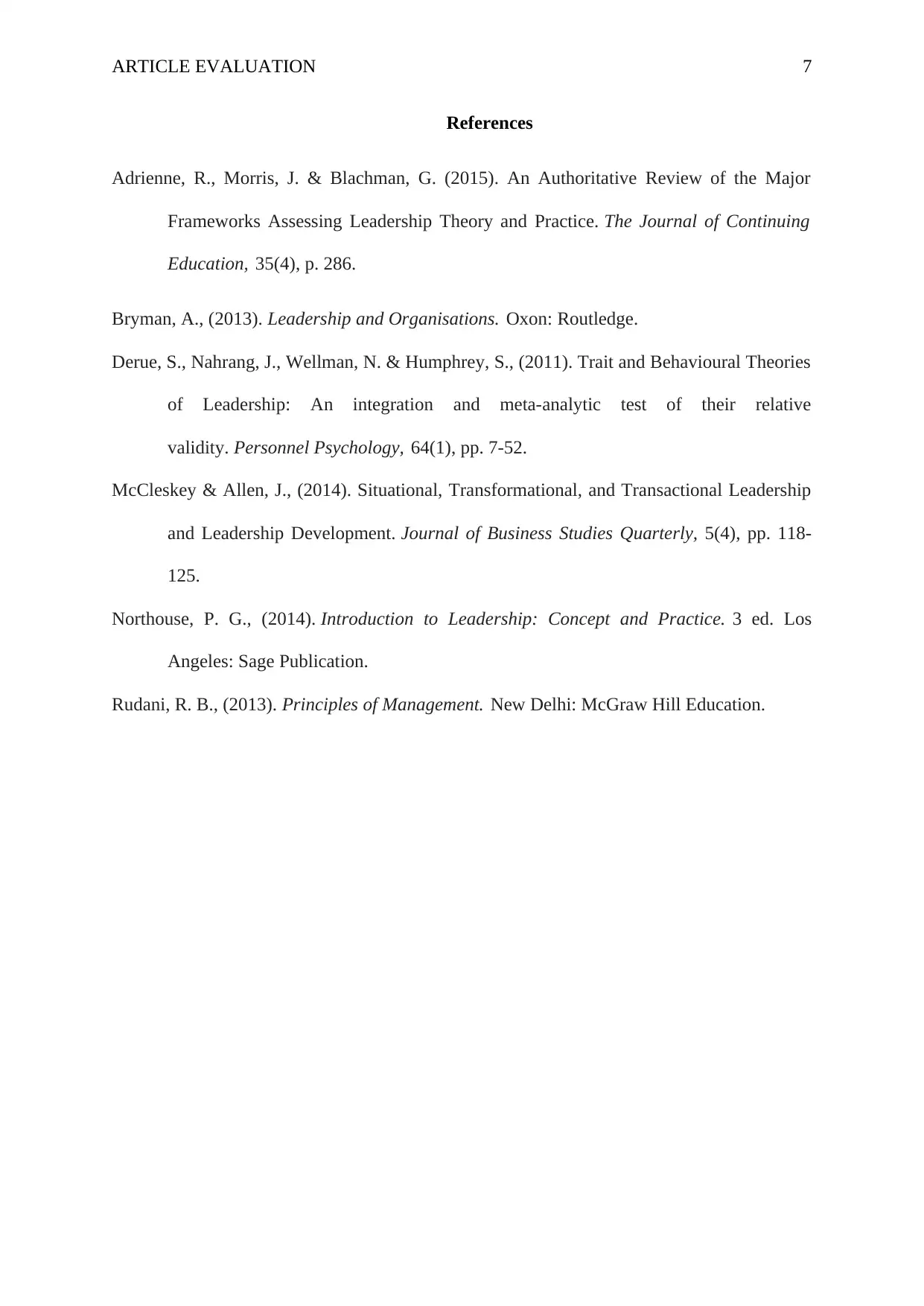
ARTICLE EVALUATION 7
References
Adrienne, R., Morris, J. & Blachman, G. (2015). An Authoritative Review of the Major
Frameworks Assessing Leadership Theory and Practice. The Journal of Continuing
Education, 35(4), p. 286.
Bryman, A., (2013). Leadership and Organisations. Oxon: Routledge.
Derue, S., Nahrang, J., Wellman, N. & Humphrey, S., (2011). Trait and Behavioural Theories
of Leadership: An integration and meta-analytic test of their relative
validity. Personnel Psychology, 64(1), pp. 7-52.
McCleskey & Allen, J., (2014). Situational, Transformational, and Transactional Leadership
and Leadership Development. Journal of Business Studies Quarterly, 5(4), pp. 118-
125.
Northouse, P. G., (2014). Introduction to Leadership: Concept and Practice. 3 ed. Los
Angeles: Sage Publication.
Rudani, R. B., (2013). Principles of Management. New Delhi: McGraw Hill Education.
References
Adrienne, R., Morris, J. & Blachman, G. (2015). An Authoritative Review of the Major
Frameworks Assessing Leadership Theory and Practice. The Journal of Continuing
Education, 35(4), p. 286.
Bryman, A., (2013). Leadership and Organisations. Oxon: Routledge.
Derue, S., Nahrang, J., Wellman, N. & Humphrey, S., (2011). Trait and Behavioural Theories
of Leadership: An integration and meta-analytic test of their relative
validity. Personnel Psychology, 64(1), pp. 7-52.
McCleskey & Allen, J., (2014). Situational, Transformational, and Transactional Leadership
and Leadership Development. Journal of Business Studies Quarterly, 5(4), pp. 118-
125.
Northouse, P. G., (2014). Introduction to Leadership: Concept and Practice. 3 ed. Los
Angeles: Sage Publication.
Rudani, R. B., (2013). Principles of Management. New Delhi: McGraw Hill Education.
1 out of 7
Related Documents
Your All-in-One AI-Powered Toolkit for Academic Success.
+13062052269
info@desklib.com
Available 24*7 on WhatsApp / Email
![[object Object]](/_next/static/media/star-bottom.7253800d.svg)
Unlock your academic potential
Copyright © 2020–2025 A2Z Services. All Rights Reserved. Developed and managed by ZUCOL.



